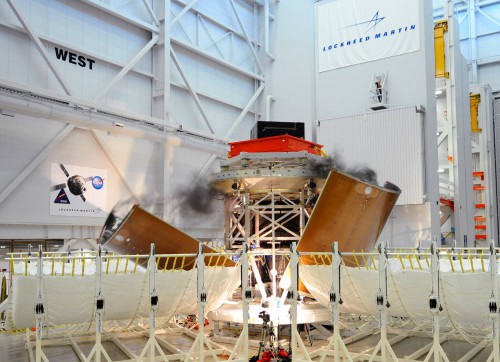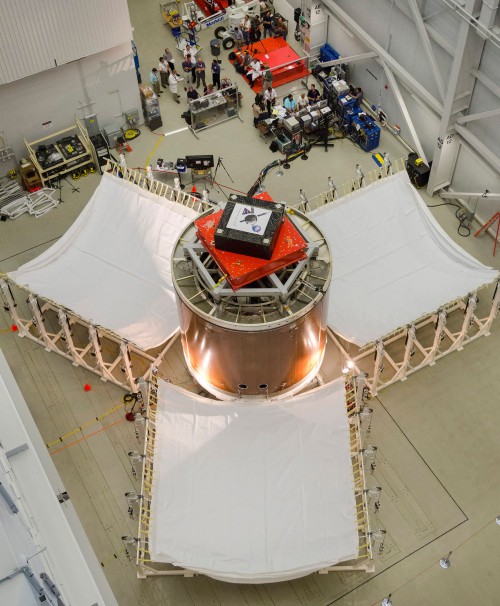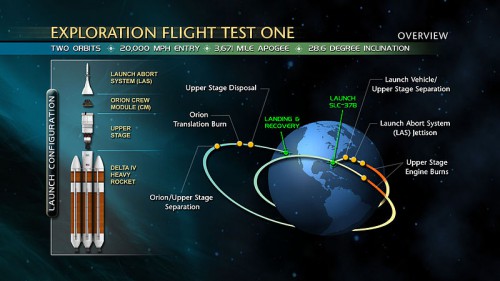
At first blush, the fairing of the Orion Multi-Purpose Crew Vehicle (MPCV) might not seem to be a vital piece of equipment; however, it is crucial. NASA is currently testing the fairing that will be used on the first flight of Orion, dubbed Exploration Flight Test 1, or “EFT-1,” which is currently slated to take place in September 2014. With just 15 months left before this all-important flight, NASA conducted the first test of this protective shell which covers the Orion spacecraft as it ascends out of the Earth’s atmosphere on Monday, June 10. As important as this component is, getting rid of it when it is time is even more so. In the first of three planned tests things did not go precisely as planned. While two of the panels separated as planned, the third panel did not.

The fairing test, which was conducted at Lockheed-Martin’s Sunnyvale, Calif., facility involved pyrotechnic mechanisms and bolts firing to separate the fairing’s panels. As mentioned, one panel failed to separate completely. According to a statement released by NASA, initial indications point to contact interference as the primary culprit behind the failure. This failure could be used to modify the fairing’s design, if it is viewed as necessary. Engineers continue to evaluate the data gleaned from Monday’s test.
“Developing a spacecraft capable of carrying humans to destinations in deep space is no easy task,” said Dan Dumbacher, NASA’s deputy associate administrator for exploration systems development. “We are testing Orion in a variety of ways so we can improve our understanding of how the spacecraft will perform in space. Even though this test was not flawless, the data we obtained will be tremendously helpful going forward.”
This test was held to review how the fairing would handle normal mechanical loads that the assembly is expected to encounter on EFT-1. A test stand stood in for Orion and engineers attached approximately 30,000 pounds so as to recreate the stresses that launch will place on the structure.
NASA and Lockheed-Martin are planning to conduct the second test later this summer. Thermal loads will be added to the equation for the second test with one panel being heated to 200 degrees Farenheit. This will force the sections to expand and could alter how it behaves. The last test is currently set to take place sometime next year.
If all goes according to plan, Orion will ride to orbit safely cocooned in its fairing. Upon reaching orbit, at an altitude of some 560,000 feet, the panels, through the pyrotechnic charges, are blasted away from the spacecraft. These fairings are instrumental when it comes to protecting Orion from the acoustics (to say that a launch is a loud event is quite the understatement), wind, and heat associated with launch.
Each of the fairing’s panels is about 14 feet high and some 13 feet wide. They will cover the service module component of Orion. While fairings currently used on other rockets in service merely cover the spacecraft shielded inside, the ones being developed for use on Orion also support about half of the spacecraft’s weight as well as the weight of the Launch Abort System that is perched atop the fairing. According to NASA, this has been done to help maximize both the size as well as the capabilities of Orion.

Total, there are twelve breakable joints and bolts that connect the fairing to the launch vehicle. In what can be described as technological ballet, the joints are fired apart, followed by the bolts. After the detonation of these elements, six springs will then push the panels away from Orion. Orion will then be free to conduct its mission.
For the EFT-1 mission, Orion will travel out to a distance of 3,600 miles and then return back to Earth. When it does so, it will reenter the Earth’s atmosphere at more than 25,000 miles per hour. It will then splash down in the Pacific Ocean. According to NASA’s Orion Program Manager Mark Geyer, the Orion Flight Test Article that will conduct the EFT-1 mission will be reused on other flights to validate the spacecraft’s design.
EFT-1 will provide engineers with a better understanding of how the Orion spacecraft performs in the harsh space environment—before crews use the vehicle to travel beyond low-Earth orbit for the first time in more than 40 years.
“This was a challenging system to design and test,” Geyer said. “Completing this test helps us evaluate our design and assure mission safety and success.”
Want to keep up-to-date with all things space? Be sure to “Like” AmericaSpace on Facebook and follow us on Twitter: @AmericaSpace



